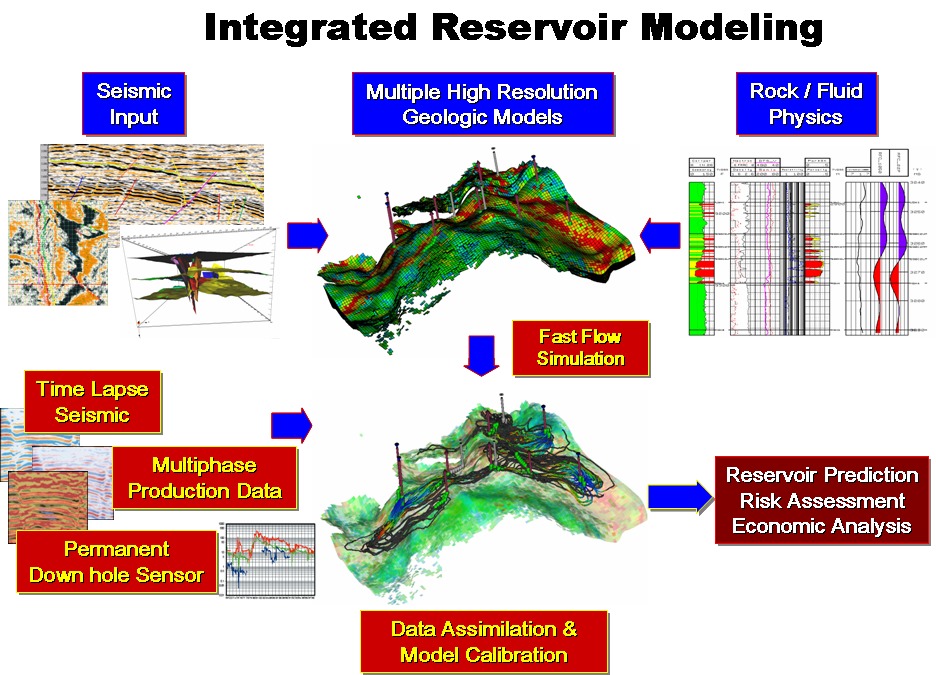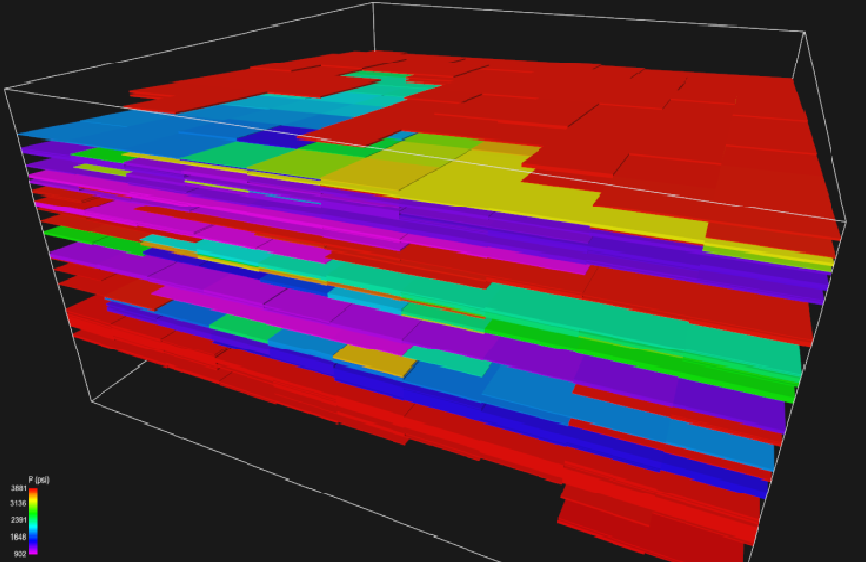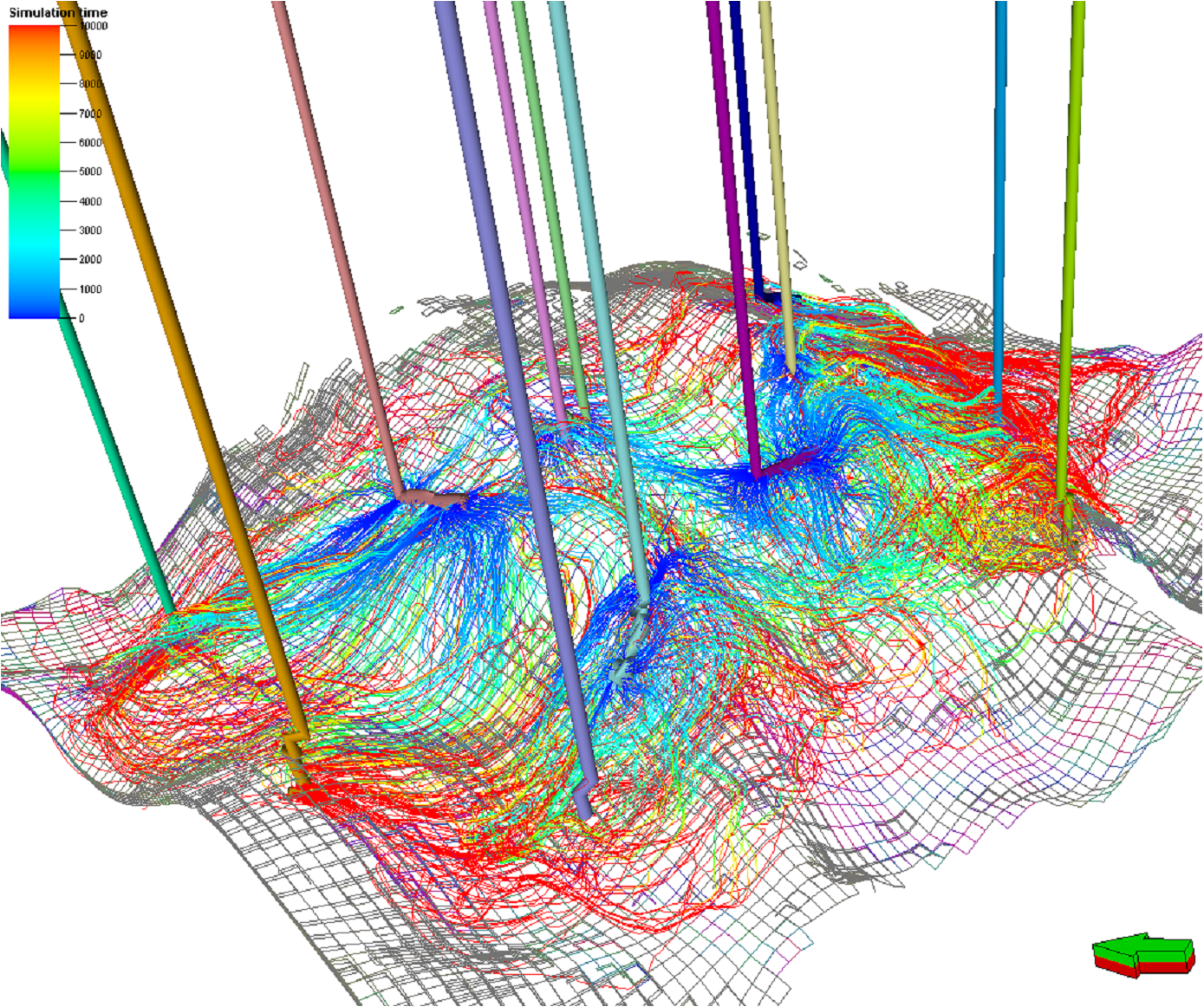|
Reconciling
high resolution geologic models to dynamic data such as transient
pressure,
tracer and multiphase production history or time-lapse seismic data is
by far
the most time-consuming aspect of the workflow for both geoscientists
and
engineers. The situation is further complicated by the rapid progress
in
well-construction technology and the advent of smart wells and
permanent
down-hole sensors. The amount of data collected is increasingly
becoming
overwhelming and there is an immediate need to improve our capabilities
to
utilize the data in a timely and efficient manner. Furthermore, as the
use of
time-lapse seismic becomes more common in the industry, there is also
an
increasing demand for quantitative and efficient use of these data for
reservoir characterization in addition to reservoir monitoring. A focus of the MCERI research consortium has
been the development of novel techniques and efficient workflows for
reconciling high resolution geologic models to pressures, rates, fluid
production and time lapse seismic response. This includes geologically
consistent regionalization and re-parameterization, identification of
spatial
distribution of reservoir properties, and uncertainty quantification.

Integrated reservoir
modeling approach
How
coarse is coarse and how fine is fine? This is an often asked question
in
reservoir simulation and modeling. We have developed novel adaptive
upgridding
algorithms to address this question through the design of simulation
grids that
optimally preserve the reservoir heterogeneity and geologic features.
These
techniques have been extensively applied to simulation layer design for
both
conventional and unconventional reservoirs.

Adaptive upgridding of high
resolution geologic models
A
more recent focus of the MCERI consortium has been development of novel
approaches for performance analysis and optimization of unconventional
wells. Using
high frequency asymptotic methods we have generalized the concept of
depth of
investigation to unconventional wells with multistage hydraulic
fractures using
a ‘diffusive time of flight (DTOF)’. The DTOF can be
computed using fast
marching methods for visualization of well drainage volumes in the
presence of
hydraulic and natural fractures. The fast marching methods can be
orders of
magnitude faster than conventional reservoir simulators and allow for
efficient
computation of pressure and rate transient response, matrix-fracture
parameter
estimation and optimization of well completion strategy. More
importantly, in a
manner analogous to streamline simulation, we can use the DTOF as a
spatial
coordinate to reduce the 3-D diffusivity equation into an equivalent
1-D
equation leading to a comprehensive and fast flow simulator for
unconventional
oil and gas reservoirs with relevant micro and nano-scale physics
including
multiphase and compositional effects (patent pending, 2013).

Visualizing evolution of well
drainage volumes in unconventional reservoirs using the Fast Marching
Method
A
major emphasis of the MCERI research consortium has been field
application and
validation of the novel technologies in close collaboration with the
industrial
partners.
Some
recent MCERI publications are listed below.
- Zhang, Y., Bansal, N., Fujita, Y.,
Datta-Gupta, A., King, M. J., and Sankaran, S.,
From Streamlines to Fast Marching: Rapid
Simulation and Performance Assessment
of Shale Gas Reservoirs Using Diffusive Time of Flight as a Spatial
Coordinate, Presented at the SPE Unconventional
Resources Conference – USA held in The Woodlands, Texas, USA, 1-3
April 2014.
- Zhang, Y., Yang, C., King, M. J. and
Datta-Gupta,
A.Fast-Marching Methods for Complex Grids and
Anisotropic Permeabilities: Application to Unconventional Reservoirs, SPE 163637 presented at the SPE Reservoir
Simulation Symposium held in The Woodlands, Texas USA, 18–20
February 2013.
- Rey, A., Bhark, E., Gao, K.,
Datta-Gupta, A.
and Gibson, R., Streamline-based integration of time-lapse seismic and
production data into petroleum reservoir models,” Geophysics,
77 (6), December (2012).
- Zhang, Y., King, M. J. and
Datta-Gupta, A.,
Robust Streamline Tracing Using Inter-Cell Fluxes in Locally Refined
and
Unstructured Grids, Water Resources Research, 48, W06521,
doi:10.1029/2011WR011396
(2012).
- Bhark, E., Rey, A., Datta-Gupta, A.
and
Jafarpour, B., A Multiscale Workflow for History Matching in Structured
and
Unstructured Grid Geometries, SPE Journal, 17(3), September 2012, Pages
828-848.
Technology
Transfer
We
will work closely with member companies whenever there is an interest
in
technology transfer via either integration with internal company
software or
via commercialization. In addition, we plan to disseminate the
information to
member companies via the following mechanisms.
We
plan to hold at least one annual meeting to present our research
progress to
the industrial sponsors. Detailed annual reports and source code for
all the
softwares developed under this project will also be provided to the
sponsor. A
semi-annual progress report will also be sent to sponsors.
- On-site
Meeting and Training on Request
We
will be willing to visit the member companies on-site to discuss
research
projects or provide training for the softwares developed under this
project as
long as the cost of such visits are borne out by the companies.
Membership
Benefits of joining the
consortium include annual meeting,
detailed annual report, semi-annual progress report and access to the
source code of all software developed under the project. In addition,
we will visit the member companies on request to discuss research
projects or provide limited training for the software.
Organizations interested
in becoming members of MCERI should
contact:
Professor
Akhil
Datta-Gupta
Harold Vance Department
of Petroleum
Engineering
Texas A&M University,
TAMU 3116
Phone: (979) 847-9030, Fax: (979) 862-1272
Email: datta-gupta@tamu.edu
Professor
Michael
King
Harold Vance Department
of Petroleum
Engineering
Texas A&M University,
TAMU 3116
Phone: (979) 845-1488, Fax: (979) 862-1272
Email: mike.king@tamu.edu
|



